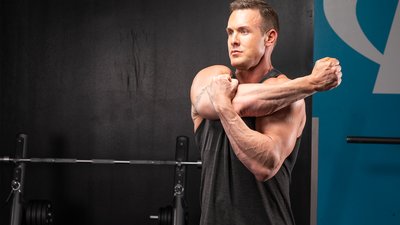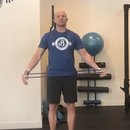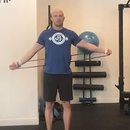The shoulders are the number one chronically pissed-off area of the body among the active population—lifters and otherwise. But as every serious lifter knows, battling cranky shoulders can be a particularly frustrating endeavor in the weight room. Even just pain can derail your performances on numerous big lifts, limiting your ability to make muscle and strength gains.
Look around the gym and you'll see that the solution many people are trying is to "mobility the shit" out of your shoulders, in the form of a cookie-cutter foam roll and stretching routine. This can take anywhere from a few minutes to half an hour, and sure, at the end of it, you may be slightly warm and a little pumped here and there.
But that doesn't make it an effective warm-up! In fact, your sorry excuse for a shoulder warm-up is probably predisposing you to pain and injuries, while also limiting your performances in the big lifts. More than any other site on the body, we must look for addition by subtraction in regard to shoulders.
Here are three classic—and dubious—warm-up exercises that are doing more harm than good, and three superior options that will alleviate shoulder pain, improve posture, and unlock your strength and power potential.
Out: Old-school arm circles
Unless you are confusing your warm-up with JV football practice from the 1970s, there is really no room for old-school circles in today's goal-oriented shoulder warm-up.
While the theory of moving your joints through cyclical rotations to increase joint lubrication has some merit, more often than not the speed and lack of control of these movements negate any benefit, and can actually increase joint and soft-tissue stress. The arm circle uses momentum to push the limits of your passive (i.e., not muscularly controlled) mobility—a bad combo.
In: Banded over-and-back
A smarter execution of the same general idea is the banded over-and-back.
The banded over-and-back is superior to the traditional arm circle for one key differentiating factor: dynamic stability. Here's what I mean: As the band is tensed between the hands, the four synergistic joints that make up the shoulder complex all link up under that tension. This enables them to coordinate and control the movement as a functioning unit.
In other words, it gives your shoulders a stimulus to stabilize, not just stretch. This stimulus is exactly what your shoulder needs moving through close to full ranges of motion.
With the simple addition of a band, we can turn a notorious shoulder-killer into a staple shoulder-saver. Try it out and become a believer.
Out: Standing internal-external shoulder rotation
There you are in front of the dumbbell rack, absentmindedly waving the lightest dumbbells you could find in and out, in and out. This move embodies classic meathead shoulder maintenance work more than any other. As you move the shoulders through internal and external rotation, you make that rotator cuff light up and get ready for action, right?
Not even close. Here's the problem: Since the weight never travels up or down and remains in the same horizontal plane of motion, the rotator cuff—which is supposedly responsible for directing rotational movements at the shoulder—never gets activated. Instead, the biceps are supporting the weight in an isometric position, which is possibly pissing off your tendons at the front side of the shoulders instead. Not exactly what you want out of your pre-bench warm-up. Doing the same movement from the side with a rotating D-handle and a cable is slightly better, but still not great.
In: Banded face pull
Here's an alternative that's far better: the banded face-pull.
This movement starts the shoulders in an internally rotated moment, and as the elbows drive back, the shoulders will naturally move into external rotation, under full tension and utilizing the supportive musculature of the upper back. It generates the same tension and synergistic linking as the banded over-and-back, but with more emphasis placed on the rotator cuff, posterior deltoid, and scapular retractors and downward rotators.
Yes, you can do these with a rope and cable, and I recommend that as a training movement. But in a warm-up, the accommodating resistance from the band is a game-changer, since it further turns on the posterior muscles of the upper body
In short, this exercise has become the single most effective shoulder-saver I've ever programmed.
Out: Across-the-chest shoulder stretch
People love stretching things that hurt. Lifters are no exception.
While stretching may elicit the temporary feel-good stimulus you are looking for, chances are it's not doing anything in terms of functionality, especially if you're hoping that functionality will hold up under loading.
No matter what gym I walk into across the world, I'm almost always guaranteed to see someone sitting on the bench with one arm pulled across the chest "stretching" their shoulders before they lay down for their next set of presses.
The problem? The shoulders are already the most inherently mobile ball and socket-based joints in the human body. Stretching an already mobile joint passively, before needing this region to be strong and stable, is a recipe for pitiful bench press numbers, and even poorer shoulder health.
In: Band pull-apart
Here's what to do instead: the band pull-apart.
Before benching, we should be activating the upper back by moving through the horizontal abduction and adduction planes of motion, and there's nothing better to do it than the band pull-apart.
By driving the hands away from one another and into the resistance of the band, the upper back and shoulder blades have to coordinate together to move the shoulder blades while the tension of the supporting musculature controls the movement actively. This is exactly what we need to bulletproof the shoulders on bench.
Remember: You are only as strong pressing as what you can stabilize from your upper back. Get stable, and you'll press big and feel great doing it.
The Rusin Banded Shoulder Triset Warm-Up
Now that you know the movements, the next step is to combine them in a smart warm-up for short-term performance enhancement and long-term pain alleviation and postural improvement.
Here's how to use all three of these smarter shoulder warm-up exercises together in the ultimate pain-free shoulder warm-up:

BodyFit
$6.99/month- 2,500+ expert-created single workouts
- 3,500+ how-to exercise videos
- Detailed workout instruction
- Step-by-step workout tips
- Training at gym or at home
- Access to Workout Plans
- Access to Bodyfit App
- Store Discounts
Already have a Bodybuilding.com account with BodyFit? Sign In

What comes with BodyFit?

- Instructional Videos
Don't risk doing a workout improperly! Avoid injury and keep your form in check with in-depth instructional videos.

- How-to Images
View our enormous library of workout photos and see exactly how each exercise should be done before you give it a shot.

- Step-by-Step Instructions
Quickly read through our step-by-step directions to ensure you're doing each workout correctly the first time, every time.
Use minimal rest between these movements. Your full focus needs to be placed on the quality of the patterns, the feel of the movements, and activation of the upper back and shoulders. After each round, rest approximately 30-45 seconds, and go back in for another round.
Enjoy your pain-free shoulders and epic bench press.




